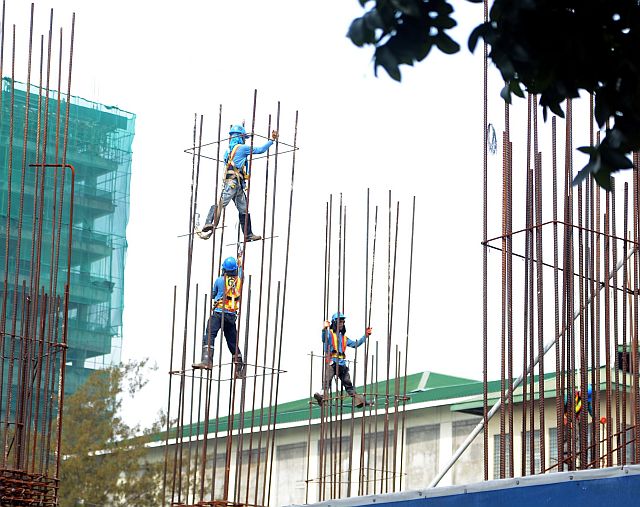Construction, export sectors to help CV’s economic rebound

Construction workers work on a building in Cebu City in this 2015 photo. According to Director Rolando Taghap of the Philippine Statistics Authority in Central Visayas (PSA-7) in a press briefing, a subsector of the construction industry contributed to the slowdown in growth of the region in 2015. With him were Romeo Recide, PSA-7 deputy national statistician and National Economic Development Authority Central Visayas Director Efren Carreon. CDN FILE and LITO TECSON
Neda-7 chief: Region 7’s growth rate drop from 7.8 percent in 2014 to 4.8 percent in 2015 temporary
The promised increase in infrastructure spending under the present administration, and the agriculture and manufacturing sectors are among the economic drivers expected to help Central Visayas’ economic growth to rebound from a slowdown in 2015.
Director Efren Carreon of the National Economic and Development Authority in Central Visayas (Neda-7) said he remains optimistic that the slowdown of the region’s growth is only temporary.
“The Central Visayas’ economy is expected to continue to be the fourth largest economy, with a rebound in manufacturing, exports, construction, and increased public sector in infrastructure under the new administration,” he said during a news conference on Central Visayas’ economic performance in 2015 on Thursday.
The Philippine Statistics Authority (PSA) reported that the region’s economy grew at a slower rate from 7.8 percent in 2014 to 4.8 percent in 2015.
In order to bounce back, Carreon said there would be a need to make the agriculture sector more resilient to weather shocks such as typhoons, flooding and dry spells.
He said the manufacturing sector should also diversify and create more products as well as identify new markets.
“If we are only bringing our export products to two or one country, if they go down, we will also go down. That’s what we experienced in the last few years,” he said.
Carreon also welcomed President Rodrigo Duterte’s plans to disperse economic development to the regions.
He said that many regions outside Luzon could offer significant contributions to the country’s economy.

Construction workers work on a building in Cebu City in this 2015 photo. According to Director Rolando Taghap of the Philippine Statistics Authority in Central Visayas (PSA-7) in a press briefing, a subsector of the construction industry contributed to the slowdown in growth of the region in 2015. With him were Romeo Recide, PSA-7 deputy national statistician and National Economic Development Authority Central Visayas Director Efren Carreon. CDN FILE and LITO TECSON
4th largest
Ronaldo Taghap, PSA Central Visayas director, said the region’s Gross Regional Domestic Product (GRDP) was valued at P483 billion in 2015 based on constant 2,000 prices and P866.9 billion based on current prices.
This makes Central Visayas the fourth largest regional economy in the country after the National Capital Region, Calabarzon, and Central Luzon.
In terms of growth rate, however, Central Visayas dropped five notches from fifth place in 2014 to tenth place in 2015.
The GRDP is the aggregate of the gross value added or income from each sector of the economy.
Sectors’ performance
The services sector emerged as the highest contributor to the Central Visayas GRDP with a 57.2 percent share, followed by industry with 36.9 percent, and Agriculture, Hunting, Forestry and Fishing (AHFF) with 5.9 percent.
Taghap said services grew 8.9 percent last year while AHFF rebounded from negative 1.9 percent in 2014 to 2.3 percent in 2015.
Industry, meanwhile, plunged from 11.3 percent in 2014 to negative 0.5 percent in 2015.
Taghap said the plummet of figures in the industry sector contributed to the region’s decelerated growth in 2015.
Cause of decline
The decline was due to the construction subsector suffering a reversal of 14.7 percent in 2014 to negative 14.7 percent last year.
Taghap cited slow implementation of construction projects especially government projects in the region as among the reasons for the construction subsector’s slowdown in growth.
Central Visayas contributed 6.4 percent to the country’s Gross Domestic Product (GDP) in 2015 and 0.31 percentage points to its 5.8-percent growth rate.
This was the first time in 12 years that the national economy grew faster than the regional economy.
Taghap said that we should work together to help the region’s economic performance to rebound from the decline in growth this year.
The economic data covered the provinces of Cebu, Bohol and Siquijor. It also included Negros Oriental, which recently became part of the newly created Negros Island Region (NIR).
For Carreon, the region’s slower growth rate in 2015 may be disappointing to some, but the 4.8-percent growth is already respectable.
Carreon said Central Visayas still has the highest six-year growth average ever recorded at 8.1 percent, even higher than the national six-year average of 6.2 percent.
Prospects bright
Melanie Ng, Cebu Chamber of Commerce and Industry president, who was present in yesterday’s event, said that prospects are bright for the region given the strong partnership between its public and private sectors.
“What we have to do is strategize, plan, and look for opportunities which are a lot of those in Central Visayas,” she added.
She said the new administration’s thrust to make it easier to do business in the country will help transform Cebu into an attractive investment destination.
Disclaimer: The comments uploaded on this site do not necessarily represent or reflect the views of management and owner of Cebudailynews. We reserve the right to exclude comments that we deem to be inconsistent with our editorial standards.
